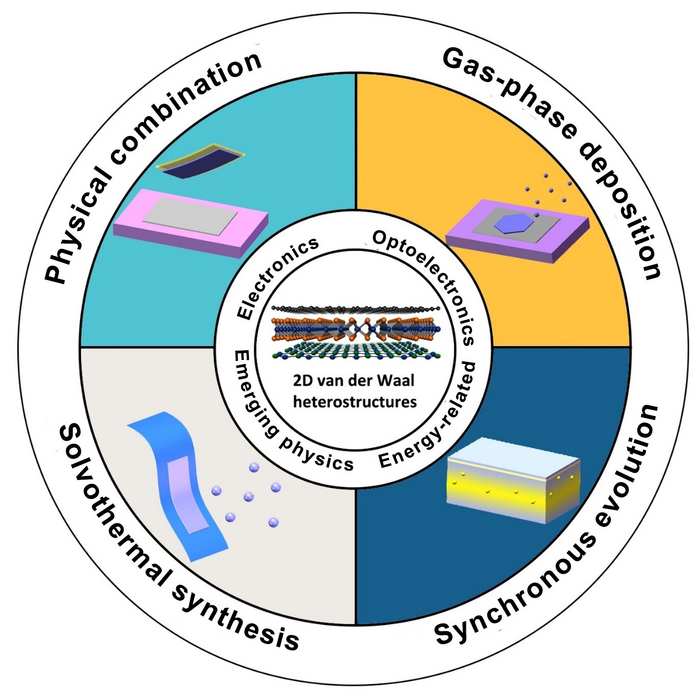The explosion of two-dimensional layered materials (2DLMs) with diverse characteristics forms the foundation for van der Waals heterostructures (vdWHs). The vdWHs coupled with different stacking alignments of 2DLMs demonstrate a wide range of interesting functions in fields such as optoelectronics, electronics, sensing, thermoelectrics, and energy conversion and storage.

In this article, the current state of the art in fabricating strategies of van der Waals heterostructures (vdWHs) will be first summarized, including physical combination, deposition, solvothermal synthesis, and synchronous evolution. Three major applications and their representative vdWH devices will then be illustrated, including electronics (tunneling field effect transistors and 2D contact), optoelectronics (photodetector), and energy conversion (electrocatalysts and metal ion batteries). Furthermore, moiré superlattices, as the representative of novel physical phenomena, will be demonstrated to show the importance of vdWHs in the fundamental study. Finally, the potential opportunities and the crucial challenges towards the fabrication and applications of vdWHs will be discussed. Image Credit: Junlei Qi, Zongxiao Wu, Wenbin Wang, Kai Bao, Lingzhi Wang, Jingkun Wu, Chengxuan Ke, Yue Xu, and Qiyuan He.
Furthermore, the novel physical phenomena accompanying vdWHs make vdWHs an ideal platform for researching condensed matter physics, particularly in low-dimensional domains.
Many solutions for the manufacture of vdWHs have been developed over the last decade to fulfill the demands of various industries. The vdWHs produced by various fabrication processes differ in critical features like layer number, cleanliness, defect density, and interface uniformity, all of which influence their application performance.
The group led by researchers from the City University of Hongkong summarized the current state of development in the fabrication and applications of vdWHs in the journal International Journal of Extreme Manufacturing to enable more rational designs of vdWHs for deeper exploration of the low-dimensional world.
The team presented the mechanism and process of significant techniques for fabricating vdWHs and compared the key properties of vdWHs created using various techniques. The potential uses of vdWHs in electronics, optoelectronics, and energy conversion and storage were then demonstrated.
The moiré superlattices based on resonant emissions were also depicted as representations of emerging unique physical phenomena. Finally, the limitations and potential opportunities of vdWH fabrication and applications were discussed.
“It is no exaggeration to say that the emergence of two-dimensional materials has provided us with a new avenue for further exploration of the world. With the exploration of 2D materials, researchers have begun to work on modulating and optimizing the properties and performance of 2D materials to meet the requirements of different practical applications. Integrating various 2D materials into vdWHs is one of the most promising strategies,” adds Qiyuan He, Director of the Research Team.
Qiyuan He adds, “VdWHs not only greatly enrich the 2D-material library but also are accompanied by numerous novel and unique physical phenomena and properties, such as moiré patterns, synergistic effect, fractal quantum hall effect, and resonant tunneling phenomenon, making vdWHs an excellent platform for studying condensed matter physics.”
Furthermore, the design idea of vdWHs is practically not limited to 2D materials, and it also shows great potential in collocations of materials in varying dimensions, including 0D, 1D, 2D, and 3D. This opens up opportunities to construct comprehensive and coherent full-dimensional physical models.
Qiyuan He, City University of Hong Kong
Thus, there is a need to develop universal and controllable fabrication techniques for vdWHs. The current review details cutting-edge vdWHs fabrication. The principal strategies are categorized into four classes: physical combination, gas-phase deposition, solvothermal synthesis, and synchronous evolution.
The vdWHs obtained by various fabrication methods have advantages and disadvantages regarding their characteristics and performance. Therefore, choosing suitable synthetic methods in different application fields is particularly crucial.
Junlei Qi, Study Co-First Author and PhD Student, City University of Hong Kong
The review demonstrated the use of vdWHs-based integration designs in electronics, photodetectors, and energy-related applications. It also covered basic research on novel physical phenomena represented by moiré superlattice.
When combined with application examples, it is demonstrated that the appropriate uses of vdWHs derived by different synthesis processes are quite varied. Mechanical assemblies, for example, are useful for researching physical processes that necessitate high-quality contacts. Meanwhile, solvothermal methods with large yields and many active sites are more suited for catalysis and energy storage.
Remarkable progress has been made in the fabrication and applications of vdWHs in the past decade, but our excavation of vdWHs is still the tip of the iceberg. On the one hand, a general synthetic method for the scalable and controllable preparation of vdWHs by design has not yet been realized, and the contradiction between high quality and high yield remains unresolved.
Qiyuan He, City University of Hong Kong
He concludes, “Although challenges are ubiquitous, the performance of devices based on vdWHs has surpassed many traditional materials. They can be used to reveal and study physical phenomena that conventional methods could not realize. It is undeniable that vdWHs have become a force to be reckoned with in multidisciplinary research and multifield applications.”
Journal Reference:
Qi J., et al. (2023) Fabrication and applications of van der Waals heterostructures. International Journal of Extreme Manufacturing. doi.org/10.1088/2631-7990/acc8a1.